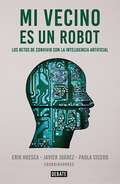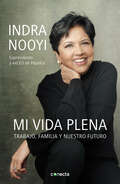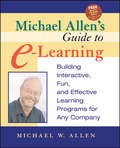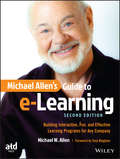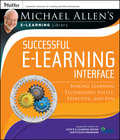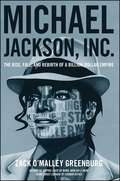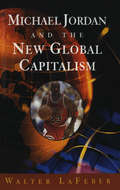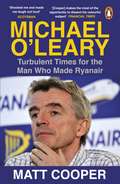- Table View
- List View
Mi vecino es un robot
by Cicero, Paola Juarez Mojica, JavierUn mosaico que refleja la complejidad de una ciencia joven que ya no es producto de una sola rama del conocimiento humano, sino de la interdependencia de todo nuestro conocimiento. Un conjunto de ensayos de expertos que evidencian cada uno de los aspectos más problemáticos de la Inteligencia Artificial con la realidad mexicana. En Mi vecino es un robot se busca explorar qué es la Inteligencia artificial más allá de la categoría simplista que se le ha otorgado como tecnología. Busca abordar algunos de los principales mitos y crear una amalgama que refleje el valor de un área en desarrollo del conocimiento humano, abriendo al lector los caminos por desarrollar y explorar que tiene como ciencia y promoviendo, en algunos casos, una perspectiva crítica sobre sus retos e implicaciones. En la medida que entendamos a la IA, sus impactos y sus retos, estaremos en condiciones de proponer medidas, como lectores y como sociedad, sobre cuál es el rumbo que queremos seguir a fin de que la tecnología no se convierta en otro factor de desigualdad.
Mi vida plena: Trabajo, familia y nuestro futuro
by Indra NooyiUn íntimo y poderoso libro de memorias de la pionera ex-CEO de PepsiCo Durante sus doce años como una de las más admiradas CEO del mundo, Indra Nooyi redefinió lo que significa ser un líder excepcional. La primera mujer de color e inmigrante en dirigir una de las 50 compañías más importantes listadas por Fortune y una de las estrategas más destacadas de nuestro tiempo transformó PepsiCo con una visión única, una vigorosa búsqueda por la excelencia y un gran sentido del propósito. En sus memorias nos cuenta con gracia, valor y buen humor su legendaria carrera y los sacrificios realizados. Nooyi nos lleva a través de los eventos que la forjaron desde su infancia y primeros años de escuela en la India de 1960, pasando por la Escuela de negocios de Yale, hasta su ascenso como consultora y estratega que pronto alcanzó el más alto de los puestos ejecutivos. El libro ofrece una mirada al interior de PepsiCo y cómo, durante su liderazgo, Indra logró reinventar la imagen de una de las empresas más icónicas de Estados Unidos, a través de productos sanos y un enfoque en el medio ambiente, a pesar de la resistencia que enfrentó en todo momento. Por primera vez y con lujo de detalles, Indra también comparte las dificultades que afrontó al compaginar su demandante trabajo con una familia en ciernes y las grandes lecciones que aprendió en el camino. Ella hace una llamada clara y urgente a las empresas y a los gobiernos a priorizar ecosistemas de cuidado, licencias con goce de sueldo y flexibilidad laboral. Sostiene que mejorar las empresas y el apoyo comunitario a las familias jóvenes liberará el potencial económico que todos deseamos. Generosa, imperativa y basada en experiencias reales, Mi vida plena es la historia de una extraordinaria líder, un tributo a lasrelaciones que la crearon y una huella para la prosperidad del siglo xxi. “Rara vez se tiene la oportunidad de ver cómo se moldea una líder de la talla global de Indra K. Nooyi. Indra comparte sus aprendizajes, su desarrollo, la evolución de su pensamiento con una generosidad y transparencia sin igual. Corre la cortina y deja entrar al lector a su vida. Una biografía única de una mujer sin igual.” -Paula Santilli, CEO PepsiCo Latino América
Mia Mia Aboriginal Community Development
by Michael Wright Cheryl Kickett-Tucker Dawn Bessarab Juli CoffinUntil recently, Aboriginal people have been subjected to mainly top-down development, which has proven damaging to communities. Mia Mia Aboriginal Community Development offers an alternative to such approaches, promoting cultural security in order to empower Aboriginal people to strengthen their own communities. The authors take a multidisciplinary approach to the topics of Aboriginal community development, Aboriginal history, cultural security and community studies. This book includes chapters examining historical and contemporary Aboriginal conceptions of community development, and the effects of post-structuralism, post-modernism, globalisation and digital technology. As well as comprehensive analysis of community development in Aboriginal communities, it presents practical strategies and tools for improvement. Each chapter includes practical case studies and review exercises, encouraging active learning and reflection. A valuable resource for tertiary education students, this book features contributions from some of Australia's most eminent Aboriginal scholars, Elders and Aboriginal community members alongside contributions from community development practitioners.
Miami Babylon
by Gerald PosnerHere, in all its neon-colored, cocaine-fueled glory, is the never-before-told story of the making of Miami Beach. Gerald Posner, author of the groundbreaking investigations Case Closed and Why America Slept, has uncovered the hair-raising political-financial-criminal history of the Beach and reveals a tale that, in the words of one character, "makes Scarface look like a documentary." From its beginnings in the 1890s, the Beach has been a place made by visionaries and hustlers. During Prohibition, Al Capone had to muscle into its bootlegging and gambling businesses. After December 1941, when the Beach was the training ground for half a million army recruits, even the war couldn't stop the party. After a short postwar boom, the city's luck gave out. The big hotels went bankrupt, the crime rate rose, and the tourists moved on to Disney World and the Caribbean. Even after the Beach hosted both national political conventions in 1972, nobody would have imagined that this sandy backwater of run-down hotels and high crime would soon become one of the country's most important cultural centers. But in 1981, 125,000 Cubans arrived by the boatload. The empty streets of South Beach, lined with dilapidated Art Deco hotels, were about to be changed irrevocably by the culture of money that moved in behind cocaine and crime. Posner takes us inside the intertwined lives of politicians, financiers, nightclub owners, and real estate developers who have fed the Beach's unquenchable desire for wealth, flash, and hype: the German playboy who bought the entire tip of South Beach with $100 million of questionable money; the mayoral candidate who said, "If you can't take their money, drink their liquor, mess with their women, and then vote against them, you aren't cut out for politics"; the Staten Island thug who became king of the South Beach nightclubs only to have his empire unravel and saved himself by testifying against the mob; the campaign manager who calls himself the "Prince of Darkness" and got immunity from prosecution in a fraud case by cooperating with the FBI against his colleagues; and the former Washington, D. C. , developer who played hardball with city hall and became the Beach's first black hotel owner. From the mid-level coke dealers and their suitcases of cash to the questionable billions that financed the ocean-view condo towers, the Beach has seen it all. Posner's singular report tells the real story of how this small urban beach community was transformed into a world-class headquarters for American culture within a generation. It is a story built by dreamers and schemers. nd a steroid-injected cautionary tale.
Miami Price: Bidding on an Iconic Transit-Oriented Development Site
by Charles F Wu Sayiddah Fatima McCree Aaron Stolear Vitali Bourchtein13th Floor-Adler, a partnership of 13th Floor Investments and Adler Group, was compiling a response to a Miami-Dade County Request for Proposal (RFP). The RFP's prize was the opportunity to develop a 7.5+/- acre parking lot, adjacent to a heavy-rail rapid transit station, into a Transit-Oriented Development (TOD) in Miami. To win, 13th Floor-Adler, had to submit a proposal that was the "highest and best use" for the land, catered to the County's demands for workforce housing, provided a market return for investors and compensated the County for the use of the land. Throughout its history, Miami has been subject to a number of real estate booms and busts. Intricate expertise of Miami's demand drivers were necessary in order to succeed. Arnaud Karsenti (MBA 2006), founder and Principal at 13th Floor Investments (13th Fl), with over $1B worth of completed transactions in the South Florida market, had this well of expertise. Furthermore, the partnership with the Adler Group, headed by Michael M. Adler, provided additional credibility for the proposal due to their 50+ years' experience in Miami. At "Link @ Douglas," can Karsenti and his team be "placemakers" creating a true live, work, and play environment, deliver market returns to investors and create a winning proposal that caters to the demands of the Miami-Dade County officials?
Miami's Tech Future (A): Twenty-first Century Changes and Challenges
by Rosabeth Moss KanterBy the middle of the 1990s, Miami's reputation was changing. An influx of Spanish-speaking immigrants and major investments in the airport and seaport had changed the image of a sleepy southern city to the de facto business center of Latin America, a center for commerce connecting the Americas. But going into the millennium, Miami and South Florida were still known primarily as seasonal tourist destinations, with all the economic and occupational challenges that entailed. Then, between 2000 and 2010, an activist Miami mayor, Manny Diaz, and a handful of civic leaders including foundation heads, undertook investments that began a significant transformation, improving Miami's economy and quality of life, making residents feel that it was more than a region for tourists. The question in 2011 was what needed to be done to further the transformation, especially in light of fears about what new technology would mean for jobs. What should be the theme or main focus? Who should lead change? This case series begins with data on the situation in 2000, discusses progress between 2000 and 2010, and identifies a possible new regional initiative that is just an idea in 2011. Is it the right direction? And what would it take to have impact on Miami's future?
Miami's Tech Future (B): Building the Entrepreneurial Ecosystem
by Rosabeth Moss KanterIn 2017, the Miami-Ft. Lauderdale metropolitan area was ranked first in the nation for startup activity. It had been number one in 2013 based on 2012 date and remained in the top three for subsequent years. The intentional shaping of an entrepreneurial ecosystem was well underway, facilitated by a range of incubators and accelerators that supported new ventures as well as an entrepreneurial culture and a new set of community connections.
Miami's Tech Future (C): Reaching Another Miami
by Rosabeth Moss KanterFor all its diversity, the Miami region remained deeply segregated, with significant income disparities and a disconnect between the tech startup world and poor communities. In 2012, soon after Miami Program Director Matt Haggman conceived of the Knight Foundation's effort to boost Miami's entrepreneurial ecosystem, CEO Alberto Ibarg en discussed with him that there was another Miami out there that the proposed initiative should be touching. In some communities, gentrification was driving residents out, while other communities were simply left out.
Miami's Tech Future (D): Developing New Leadership
by Rosabeth Moss KanterTo solve today's problems and build tomorrow's economy and community "will take a generational turnover of leadership," one millennial entrepreneur said in mid 2017. It might also take a shift of culture and expectations. What differentiated the rising entrepreneurial generation was not just youth but an innovative mindset, manifested throughout the efforts to change Miami. They were not stuck within the traditional structures or established institutions; they were willing to "think outside the building." A set of common modes showed up in the emerging entrepreneurial ecosystem whether founding tech ventures or rebuilding community.
Michael Allen's Guide to E-Learning
by Michael W. AllenAn industry leader speaks out against boring, ineffective, costly e-learning and provides practical guidelines for creation of powerful, e-learning-based performance solutions. e-Learning is emerging rapidly in schools, businesses, and at home. Millions are being invested in this new, widely available technology purported as the solution to learning challenges. Dr. Michael Allen, commonly considered the father of modern interactive learning, raises concerns about misuses of the technology, missed opportunities, and money wasted on boring, ineffective e-learning. The book offers specific, pragmatic, common-sense approaches to guide the development of successful technology-assisted learning. A free CD-ROM is packed with sample applications. Michael Allen's Guide to e-Learning enables business executives to become discerning e-learning investors and instructional designers to create meaningful performance solutions.
Michael Allen's Guide to e-Learning: Building Interactive, Fun, and Effective Learning Programs for Any Company
by Michael W. Allen Tony BinghamExplore effective learning programs with the father of e-learning Michael Allen's Guide to e-Learning: Building Interactive, Fun, and Effective Learning Programs for Any Company, Second Edition presents best practices for building interactive, fun, and effective online learning programs. This engaging text offers insight regarding what makes great e-learning, particularly from the perspectives of motivation and interactivity, and features history lessons that assist you in avoiding common pitfalls and guide you in the direction of e-learning success. This updated edition also considers changes in technology and tools that facilitate the implementation of the strategies, guidelines, and techniques it presents. E-learning has experienced a surge in popularity over the past ten years, with education professionals around the world leveraging technology to facilitate instruction. From hybrid courses that integrate technology into traditional classroom instruction to full online courses that are conducted solely on the internet, a range of e-learning models is available. The key to creating a successful e-learning program lies in understanding how to use the tools at your disposal to create an interactive, engaging, and effective learning experience. Gain a new perspective on e-learning, and how technology can facilitate education Explore updated content, including coverage regarding learner interface, gamification, mobile learning, and individualization Discuss the experiences of others via targeted case studies, which cover good and not so good e-learning projects Understand key concepts through new examples that reinforce essential ideas and demonstrate their practical application Michael Allen's Guide to e-Learning: Building Interactive, Fun, and Effective Learning Programs for Any Company, Second Edition is an essential resource if you are studying for the e-Learning Instructional Design Certificate Program.
Michael Allen's Online Learning Library: Successful e-Learning Interface
by Michael W. AllenMost e-learning is designed using instructional model that were first introduced more than thirty years ago as a solution to classroom training, In this must-have book, Allen reviews the basics of instructional design and then lifts the lid on some common misconceptions that arise from what people think they know about ISD. Although e-learning benefits from all the traditional characteristics of instructional design, it also has unique requirements, so Allen focuses on how to think differently about ISD and shows where and how it needs to be modified to make applicable to the unique world of e-learning.
Michael Bregman
by Howard H. Stevenson Richard O. Von WerssowetzMichael Bregman has successfully opened pilot installations of two different restaurant concepts. He now must develop a strategy for growth, including decisions about fast or slow growth, use of company-owned versus franchised units, and how to use the different concepts. To do this, Michael must give particular consideration to the pros and cons of franchising.
Michael Fernandes at Nicholas Piramal
by Nitin Nohria Michel AntebyMichael Fernandes, the Director of Custom Manufacturing Operations at the pharmaceutical company Nicholas Piramal India Limited (NPIL), schedules a meeting with three of his reports, whose interpersonal conflicts with one another are causing his business development function to falter. He struggles to know how to handle these conflicts and bring the three into a productive working collaboration. Fernandes is in charge of incorporating NPIL's new acquisitions in Canada and the United Kingdom to market NPIL globally. His three direct reports are each involved in different aspects of NPIL--the Canadian operations, the British operations, and the global business development, and the case explores the team dynamics among them. Unless Fernandes can resolve the conflicts, the integration of the acquisitions is in jeopardy.
Michael Jackson, Inc.
by Zack O'Malley GreenburgThe surprising rags-to-riches-to-rags-to-riches story of how Michael Jackson grew a billion-dollar business.Michael Jackson is known by many as the greatest entertainer of all time, but he was also a revolutionary when it came to business. In addition to famously buying the Beatles' publishing catalogue, Jackson was one of the first pop stars to launch his own clothing line, record label, sneakers, and video games--creating a fundamental shift in the monetization of fame and paving the way for entertainer-entrepreneurs like Jay Z and Diddy. All told, Jackson earned more than $1.1 billion in his solo career, and the assets he built in life have earned more than $700 million in the five years since his death--more than any other solo music act over that time. Michael Jackson, Inc. reveals the incredible rise, fall, and rise again of Michael Jackson's fortune--driven by the unmatched perfectionism of the King of Pop. Forbes senior editor Zack O'Malley Greenburg uncovers never-before-told stories from interviews with more than 100 people, including music industry veterans Berry Gordy, John Branca, and Walter Yetnikoff; artists 50 Cent, Sheryl Crow, and Jon Bon Jovi; and members of the Jackson family. Other insights come from court documents and Jackson's private notes, some of them previously unpublished. Through Greenburg's novelistic telling, a clear picture emerges of Jackson's early years, his rise to international superstardom, his decline--fueled by demons internal and external, as well as the dissolution of the team that helped him execute his best business moves--and, finally, his financial life after death. Underlying Jackson's unique history is the complex but universal tale of the effects of wealth and fame on the human psyche. A valuable case study for generations of entertainers to come and for anyone interested in show business, Michael Jackson, Inc. tells the story of a man whose financial feats, once obscured by his late-life travails, have become an enduring legacy.
Michael Jordan and the New Global Capitalism (New Edition)
by Walter LafeberWalter LaFeber's timely analysis looks at the ways that triumphant capitalism, coupled with high-tech telecommunications, is conquering the nations of the world, one mind--one pair of feet--at a time. With Michael Jordan and the New Global Capitalism, Walter LaFeber has written a biography, a social history, and a far-ranging economic critique. From basketball prodigy to international phenomenon to seductive commercial ideal, Michael Jordan is the supreme example of how American corporations have used technology in a brave, massively wired new world to sell their products in every corner of the globe. LaFeber's examination of Nike and its particular dominion over the global marketplace is often scathing, while his fascinating mini-biography of Michael Jordan and the commercial history of basketball reveal much about American society. For this new paperback edition, LaFeber has added a chapter on globalization in a changed world, after mass protests and since September 11. "Bold, riveting....Brilliantly illuminates how hyper-US capitalism has spread its financial wings around the globe."--Douglas Brinkley "LaFeber brings an impressive intellect to bear on his subject."--Barbara Rudolph, Chicago Tribune
Michael Ku and Global Clinical Supply at Pfizer Inc.: Bringing Hope to Patients (A)
by Linda A. Hill Allison J. Wigen Emily TedardsMichael Ku joined Pfizer in 2011, after the company had undergone three large-scale mergers and acquisitions. His mission was to drive the digital transformation of the company's clinical supply chain, but he knew he had to start with the culture. Over the next eight years, Ku and his leadership team put in place the culture, talent, structure, and processes necessary to prime the clinical supply chain for digital transformation. By 2019, the clinical supply chain had made significant progress toward becoming the agile, innovative organization necessary to support Pfizer's new ambition to focus exclusively on developing innovative medicines and vaccines. Ku knew there was more to be done before they could maximize their digital and innovation efforts. He had asked his leadership team to come up with a proposal to improve decision-making in the organization.
Michael Ku and Global Clinical Supply at Pfizer Inc.: Bringing Hope to Patients (B)
by Linda A. Hill Emily TedardsIn 2011, Michael Ku became Pfizer's Vice President of Global Clinical Supply (GCS) after the company had undergone three large-scale mergers and acquisitions. As Ku and his new leadership team set out to build a proactive, end-to-end, digital and physical clinical supply chain, they put in place a "Patients First" culture, developed their digital capabilities, and built out their global footprint. By 2019, GCS had made significant progress toward becoming the agile, innovative organization necessary to support Pfizer's new ambition to focus exclusively on developing innovative medicines and vaccines. Ku and his leadership team felt the time had come to implement a new cross-functional decision-making hub. They also decided to pilot a 24-hour, 5 day a week workforce model with a team of clinical pharmacists in Manila. Just as they were beginning to onboard their first hires, COVID-19 struck. GCS found itself on the front lines having to supply Pfizer's vaccine candidate and investigational antiviral studies, while also ensuring continuity of clinical supply to hundreds of other trials across the globe. By July 2020, the five-person Manila team-all of which had been on-boarded virtually-had come to play a critical role in GCS's productivity. With Phase 3 of the vaccine candidate trial looming, Ku and his leadership team had decided to double the size of the Manila team by the end of 2020. The question was, who would lead the team?
Michael Lester at Lachlan Consulting
by Anthony J. Mayo Joshua D. MargolisMichael Lester, a consultant with Lachlan, was frustrated by his client's unwillingness to provide key data for an important presentation. Lester must decide how best to confront Nadine Robert, his client, knowing that his personal success and the reputation of his consulting firm hinge on his ability to build and sustain a strong relationship. How firm should he be with the client? What type of feedback would help this situation?
Michael Milken: The Junk Bond King
by Matthew Preble Tom NicholasMichael Milken, an investment banker who dominated the junk bond market in the 1980s, was sentenced to jail in 1990 after pleading guilty to a number of securities and tax related felonies. In the preceding decade, Milken had helped usher in a new wave of leveraged buy outs (LBOs) and greatly changed the structure of corporate America. By the late 1980s though, Milken and junk bonds became more heavily scrutinized, and Milken was eventually implicated in a number of felonious acts. Even after his admission of guilt, however, observers remained divided on what Milken's true impact had been. Was he simply a misunderstood financial innovator who democratized access to capital? Or was he driven purely by greed and by nefarious personal financial motives?
Michael Milken: The Junk Bond King
by Matthew Preble Tom NicholasMichael Milken, an investment banker who dominated the junk bond market in the 1980s, was sentenced to jail in 1990 after pleading guilty to a number of securities and tax related felonies. In the preceding decade, Milken had helped usher in a new wave of leveraged buy outs (LBOs) and greatly changed the structure of corporate America. By the late 1980s though, Milken and junk bonds became more heavily scrutinized, and Milken was eventually implicated in a number of felonious acts. Even after his admission of guilt, however, observers remained divided on what Milken's true impact had been. Was he simply a misunderstood financial innovator who democratized access to capital? Or was he driven purely by greed and by nefarious personal financial motives?
Michael O'Leary: Turbulent Times for the Man Who Made Ryanair
by Matt CooperFinancial Times Business Book of the MonthSeptember 2017. Ryanair cancels over 700,000 bookings and its powerful PR juggernaut comes shuddering to a halt. For once, the airline's aggressive and flamboyant CEO, Michael O'Leary, is contrite and apologetic.A month later Ryanair announces increased passenger traffic for October, year-on-year growth and increased profits. Its share price soars. For the moment, it appears, a fundamental shake-up of Europe's biggest airline is off the table. But questions remain about the causes of the debacle and O'Leary's role in it.Michael O'Leary lifts the veil on the wildly successful and wildly controversial Ryanair CEO. Based on extensive research - including with close associates of O'Leary - the book examines O'Leary's personality, beliefs and obsessions and describes how these have moulded the business he runs. Written by a multi-award-winning journalist and broadcaster, with a thirty-year career covering business and current affairs, it is a fascinating insight into the business behind the man, and the man behind the business.'Fascinating book ... very comprehensive' Eamon Dunphy, The Stand'An indispensable guide for anyone who wants to understand not just where Michael O'Leary and Ryanair are coming from, but where they are going.' Sunday Business Post'A frequently enlightening unauthorised biography ... entertaining' Irish Independent'In a world of colourless corporate leaders, Ryanair's aggressive, mouthy chief executive provides catnip for journalists. Cooper, an award-winning Irish writer and reporter, makes the most of the opportunity to dissect his colourful subject' Book of the Month, The Financial Times
